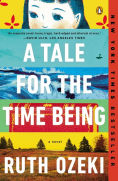Writers agonise over the first sentence of their novels, relentlessly reminded that it is critical to gaining the reader’s attention. The first sentence of this novel couldn’t be simpler:
Hi!
What better way to begin the dialogue between the characters and the reader, between ultimately the writer and the reader?
The speaker, whom we will later learn is a 16-year-old Japanese schoolgirl, immediately launches the sort of questions one might ask any new acquaintance, interspersed with her own answers. The first question, though, is odd; she asks us if we know what a “time being” is.
Thus we know right off that we are immersed in a story where words and phrases hold multiple means and can change chameleon-like depending on their context. We get further proof when we learn the young woman’s name: Nao, pronounced “now”.
Her first-person narrative is interspersed with the third-person narrative of an older woman, who finds a Hello Kitty lunchbox washed up on the beach of the island in the Pacific Northwest where she lives with her husband Oliver. The woman, who is half-Japanese, is named Ruth, again a name with multiple meanings of her name not to mention the difficult pronunciation for speakers of Japanese.
The two stories intertwine as Ruth reads Nao’s journal, which is in the lunchbox along with some letters written in an outdated form of Japanese and another journal in French.
Nao’s voice is a stunning evocation of a teenaged girl’s idiom and headlong approach to handling her problems. The way she talks to her father, whom she blames for many of her problems, took me back to my own teen years and my fraught relationship with my parents. Ozeki manages to find a way to take us into Nao’s world and to make us care about her, despite what in other hands could be clichéd teen angst.
While I enjoyed Nao’s sections, I found myself most interested in Ruth’s story, perhaps because she is closer to me in age. Her tale is more nuanced, more complex. Ruth’s ways of dealing with her outsider status, her marriage, and her curiosity about Nao reveal a depth and care that I found irresistible. She sets out to learn about the letters and French journal, while also looking for proof that Nao is a real person.
Both stories are engaging and thought-provoking. This is a book about language and communication and ambiguity. Most of all it is a meditation about time. In the last third of the book, concepts of time and quantum theory begin to be reflected in the story, adding a further dimension of interest.
Everyone in my book club loved this book, a rare show of unanimity. We found much to discuss, particularly about the various parallels of character and plot, and about time itself.
Are you in a book club? Has your group read a book recently which everyone loved?

I loved this book and enjoyed reading your review of it. Interestingly, I enjoyed Nao’s parts a little more than Ruth’s. This is a book I think I’d enjoy reading a second time.
Many readers on Goodreads preferred Nao’s parts. I thought they made up a brilliant portrait of a young woman.